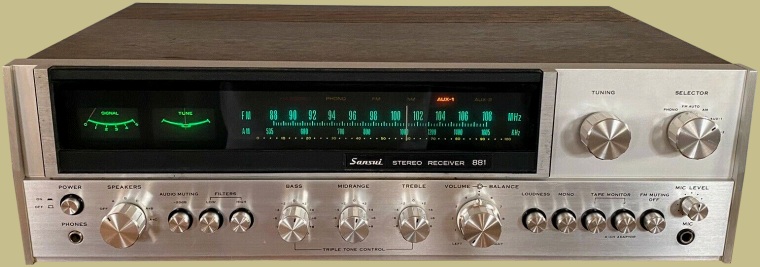
Released in 1974 the Sansui 881 retailed for $529.95 and was the top-of-the-line receiver in the Sansui lineup at the time. Others in the line included the 771, 661, 551, 441, 331, and 221. At an underrated 60 watts per channel into 8 ohms it packs plenty of power and total harmonic distortion comes in at a respectable 0.3%. Sansui claimed it was the best receiver on the market and they may have been right.
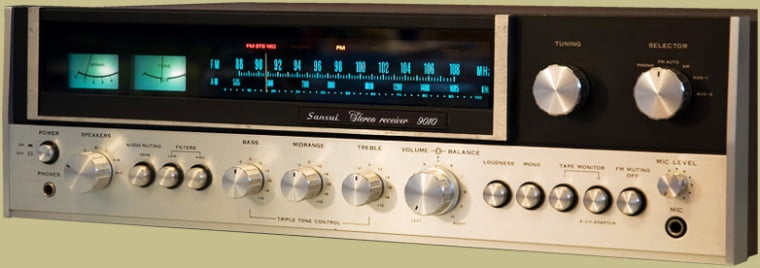
The Sansui 9010 is the same receiver as the 881 but the upper half of the front panel is black.
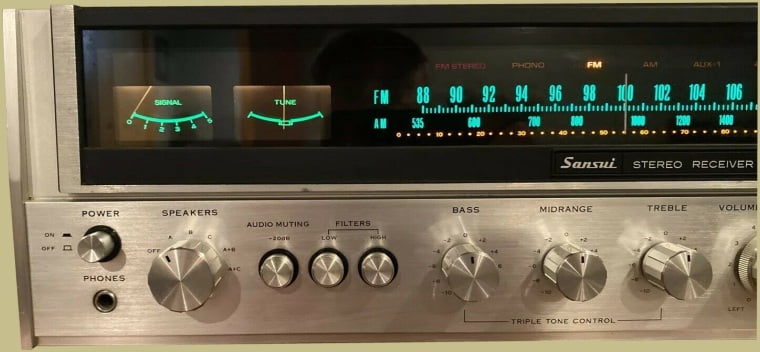
The Sansui 881’s gold anodized front panel and metal endcaps give it a clean metallic look. The black out dial face holds the tuning dial and both a signal and tuning meter. Both the dial and meters are backlit with a soft green light. The source indicator lights are orange and the FM stereo indicator light is red. It has muting, two filter switches, three tone controls, including midrange, headphone jack and a mic level control. You can see that with the speaker selector switch you can control three sets of speakers. The mid range tone control is limited to +/- 5dB which is plenty.
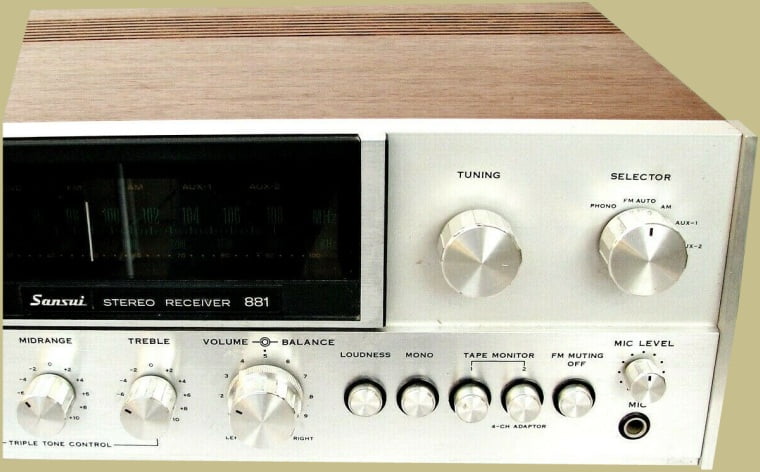
The 881’s FM tuner is good. One review tested it’s IHF sensitivity at 1.8 micro volts. Better than Sansui claimed. It’s quieting slope is extremely steep which is good. Stereo separation is excellent as well. Sansui’s rating of the 881 at 60 watts per channel is conservative. One drawback of the unit is that it’s muting and stereo thresholds are tight. That means that occasionally, with a weak but acceptable signal, it will switch to mono or mute the station completely.
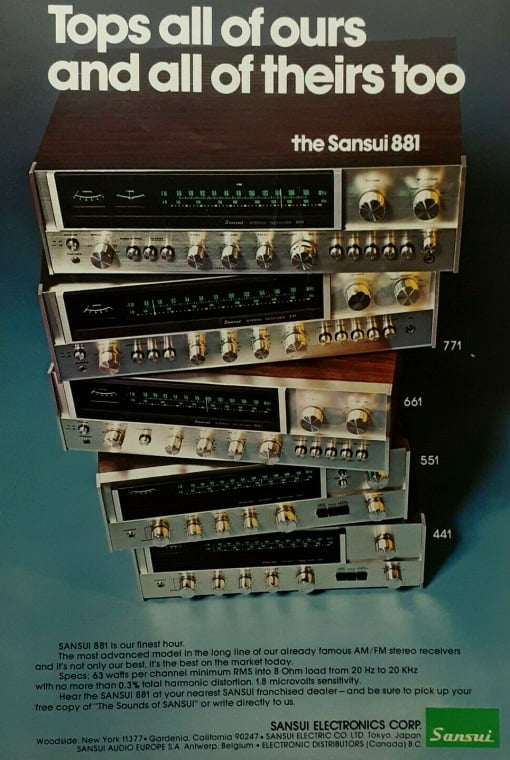
Under the cover the Sansui 881 has a nice clean layout. Notice the very large transformer and two large 10,000 uF caps. The power amplifier section is direct coupled from input to output with a differential amplifier first stage in each channel. Most of the wiring between the modules is done with multiple conductor connectors which makes removing the boards for repair or servicing fairly easy.

The Source selector switch on the 881 tends to get dirty and can cause all kinds of weird issues. A good cleaning of the pot will usually remedy any problems. The 881 also has some problems with hum. Sometimes it’s an easy fix and sometimes not (bad ground connection on a PCB, bad power supply cap, etc.)
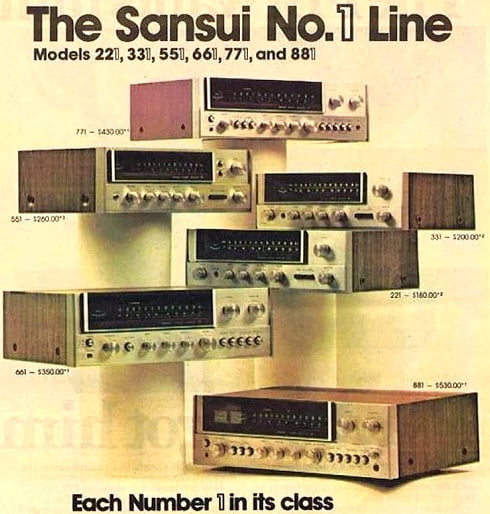
The 881 has some nice large, finned heat sinks on the back panel that you can see the transistors through. There are two sets of AUX inputs which is nice if you want to run your phone or MP3 player through the it. All the low level inputs are on the left of the rear panel while the speaker outputs are on the right.

Overall the Sansui 881 has plenty of power and produces clean sound with very minimal distortion levels. Feature wise it has about everything you would need including the two extremely useful AUX inputs. It looks great too. The bottom half of the front panel is brushed aluminum while the top half is left unbrushed. It’s an interesting touch that gives the 881 more visual texture. It’s probably the most underrated of Sansui’s top of the line receivers.
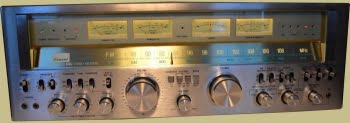
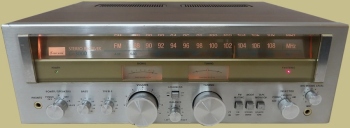
I like that Sansui mounted the fins and transistors on the rear of the unit. This means heat doesn’t end up frying the components on the inside of the chassis. It was a smart move, and one carried through for some time during these years.
i have a 551 and 661 anything 661 771 881 are all at a higher build quality best warm sounbding receivers i ever owned i also have a technics sa 700 that looks and works as it should 100 watts rms per channell for sale if intrested email me
Still available?
I just received a Sansui 331 for Christmas, my first vintage piece of equipment and I really like it. The tuner is really good, both AM and FM. Great website, thanks.
Wish me luck fellas! I’m going to throw a massive bid on one of the beautiful beasts.
I have 1000+ components/speakers in my
storage. I’m supposed to be selling them, but
I’ll get around to doing it someday. The 881, you’ll all have to wait til I die to see it on the market again. I love NAD, ADCOM, Marantz but the Japanese with Akai, Nikko, Yama, and Sansui have my heart. Oh, and my first silver baby, an HK 505 amp acquired Sophmore year high school-1982. Been hooked ever since
Do you have any Akai equipment that you may want to sell such as receivers?
I have a Sansui 881 that I might sale. Great shape! Pick up only or only delivered to near Maryland.
Tygrego2@aol.com for more infro.
Do you still have your Sansui 881? If so, I’m located in Parkton, MD for pick-up.
Thanks,
Sam
881 : effortless and seductive presentation that makes you want to listen more music.
I have a clean 771 / under rated at 40 WPC..is plenty…sounds excellent!
Still available?
Headphone must work.
Many thanks
Jim
I picked up an 881 with one channel not working . I took the advice on here, focused on cleaning the function and it’s 95% great! For some reason aux 1 will only work on one channel, but in mono will play out of both…surprisingly heavy despite is relatively small size!
Clean inside of Aux socket squirt detox and plug a jack in and out of it about 30 times.
Agreed…..also make sure you have quality, clean RCA cables
Interestingly a receiver that sounds almost exactly the same as the 881 is the Kenwood KR-6600 (also ridiculously underrated at 58wpc the real output is close to 80). I restore 70’s receivers as a hobby and have that Kenwood model for my own use. Had to beg the owner to sell it to me because that superb silky sound signature… Just had to have it. An 881 came my way a few months back and when I turned it on it sounded so much like the Kenny I thought I had fired up mine by mistake. Hooked to the same Celestial Dittons. Moreover my Focal Clear headphones also sounded the same. Really uncanny.
I would love to have a Sansui 881 again. I purchase one when I was in the military. (1974)There is nothing like that sound!
My first vintage receiver and piece of vintage gear was a 331 going back 12yrs+. I was instantly smitten by the Sui sound and styling. The 331 left with an ex, I had a couple of nice Lux amps I preferred, but I still lusted after XX1 series. I finally found an 881 this year. I paid $500nzd, $50-75 more than I really wanted, but I couldn’t pass it up.
What an excellent receiver, It is driving Tannoy Cheviots effortlessly and making them sound damned good.
What fuse goes with my Sansui 881. Moreover, where can I buy some.? Finally , if I add a digital converter to my receiver can I play my streamed music from my HP desktop computer?
I think the fuse was a 5A 117V slow blow fuse. I would assume a 5A 125V would work as well and are more common. As for the DAC, I think one would work. The 881 has RCA AUX inputs so the DAC should hook up through them.
I have a pristine, full restored 881. I still had the intermittent channel thing going on. Exactly as described by James Phillips, above. I put it in a box and left it sitting for a couple years. (I had $2000.00 into an amp I could not use). Anyway a couple months ago I dug it out again, sent it for repair and found the “input board” needed re – soldered. Losing contact because of broken solder joints. What a beast it is! I have had a few vintage receivers and none like this. I get up early just to listen to it.
I got the 881 from a yard sale, I hear the hum on the speakers but do not hear any other output from the speakers. Don’t hear fm/ am radio or any output from attached devices? There is no voice going out to speakers What next ? Thanks
The 881 is the best receiver for your money period. Plenty of power and the best smooth sound thru headphones or speakers. My daily unit is an sx1980 and the 881 is a close second.
Bought Mine in 1975, new on rt 35 NJ. The tuner has some issues now ( I bought a TU-717 instead of a fix), the amp continues to work perfect. My girlfriend at the time bought one too! We got married and have them both, complete with original boxes, schematics , etc. Best purchase considering we paid full price back then. It was a lot of money. have it hooked up to AR-215-7? speakers. The best sound. That warm sound really is there. Still have the micro acoustics. ha.
Had a Sansui 555A, very ordinary so sold it on. Bought a Sansui 331, absolutely love it, could not move it out of my music room to the study, so bought another 331, solved the problem, but, i decided to buy a 881, finally got it from USA to Australia, had my tech change voltage and check it over, picked it up today, listening to it as i type, the 881 is a 331 on steroids , muscular but smooth and non fatiguing. Having the second AUX input makes it more versatile in todays hi-fi environment.
Silky smooth sound – enveloping soundstage – and pumping bass power – one of the greatest.
I purchase a Sansui 881 in 1975. I was in the ARMY and station in Germany. Being young and not knowing what a top notch receiver it was. I would love to buy one again!